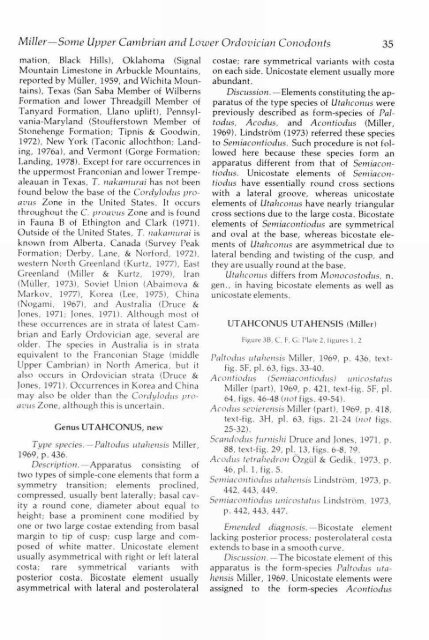View - KU ScholarWorks - University of Kansas
View - KU ScholarWorks - University of Kansas
View - KU ScholarWorks - University of Kansas
You also want an ePaper? Increase the reach of your titles
YUMPU automatically turns print PDFs into web optimized ePapers that Google loves.
Miller-Some Upper Cambrian and Lower Ordovician Conodonts 35<br />
mation, Black Hills), Oklahoma (Signal<br />
Mountain Limestone in Arbuckle Mountains,<br />
reported by MüIler, 1959, and Wichita Mountains),<br />
Texas (San Saba Member <strong>of</strong> Wilberns<br />
Formation and lower Threadgill Member <strong>of</strong><br />
Tanyard Formation, Llano uplift), Pennsylvania-Maryland<br />
(Stoufferstown Member <strong>of</strong><br />
Stonehenge Formation; Tipnis & Goodwin,<br />
1972), New York (Taconic allochthon; Landing,<br />
1976a), and Vermont (Gorge Formation;<br />
Landing, 1978). Except for rare occurrences in<br />
the uppermost Franconian and lower Trempealeauan<br />
in Texas, T. nakamurai has not been<br />
found below the base <strong>of</strong> the Cordylodus proavus<br />
Zone in the United States. It occurs<br />
throughout the C. proavus Zone and is found<br />
in Fauna B <strong>of</strong> Ethington and Clark (1971).<br />
Outside <strong>of</strong> the United States, T. nakainurai is<br />
known from Alberta, Canada (Survey Peak<br />
Formation ; Derby, Lane, & Norford, 1972),<br />
western North Greenland (Kurtz, 1977), East<br />
Greenland (Miller & Kurtz, 1979), Iran<br />
(Muller, 1973), Soviet Union (Abaimova &<br />
Markov, 1977), Korea (Lee, 1975), China<br />
(Nogami, 1967), and Australia (Druce &<br />
Jones, 1971; Jones, 1971). Although most <strong>of</strong><br />
these occurrences are in strata <strong>of</strong> latest Cambrian<br />
and Early Ordovician age, several are<br />
older. The species in Australia is in strata<br />
equivalent to the Franconian Stage (middle<br />
Upper Cambrian) in North America, but it<br />
also occurs in Ordovician strata (Druce &<br />
Jones, 1971). Occurrences in Korea and China<br />
may also be older than the Cordylodus protwos<br />
Zone, although this is uncertain.<br />
Genus UTAHCONUS, new<br />
Type species. - Paltodus utahensis Miller,<br />
1969, p. 436.<br />
Description. -Apparatus consisting <strong>of</strong><br />
two types <strong>of</strong> simple-cone elements that form a<br />
symmetry transition; elements proclined,<br />
compressed, usually bent laterally; basal cavity<br />
a round cone, diameter about equal to<br />
height; base a prominent cone modified by<br />
one or two large costae extending from basal<br />
margin to tip <strong>of</strong> cusp; cusp large and composed<br />
<strong>of</strong> white matter. Unicostate element<br />
usually asymmetrical with right or left lateral<br />
costa; rare symmetrical variants with<br />
posterior costa. Bicostate element usually<br />
asymmetrical with lateral and posterolateral<br />
costae; rare symmetrical variants with costa<br />
on each side. Unicostate element usually more<br />
abundant.<br />
Discussion. -Elements constituting the apparatus<br />
<strong>of</strong> the type species <strong>of</strong> Utaliconus were<br />
previously described as form-species <strong>of</strong> Paltodus,<br />
Acodus, and Acontiodus (Miller,<br />
1969). Lindstrôm (1973) referred these species<br />
to Semiacontiodus. Such procedure is not followed<br />
here because these species form an<br />
apparatus different from that <strong>of</strong> Semiacontiodus.<br />
Unicostate elements <strong>of</strong> Serniacontiodus<br />
have essentially round cross sections<br />
with a lateral groove, whereas unicostate<br />
elements <strong>of</strong> Utahconus have nearly triangular<br />
cross sections due to the large costa. Bicostate<br />
elements <strong>of</strong> Semiacontiodus are symmetrical<br />
and oval at the base, whereas bicostate elements<br />
<strong>of</strong> Lita/iconus are asymmetrical due to<br />
lateral bending and twisting <strong>of</strong> the cusp, and<br />
they are usually round at the base.<br />
Utahconus differs from Monocostodus, n.<br />
gen., in having bicostate elements as well as<br />
unicostate elements.<br />
UTAHCONUS UTAHENSIS (Miller)<br />
Figure 3B, C, F, G; Nate 2, t igures 1, 2<br />
Paltodus utahensis Miller, 1969, p. 436, textfig.<br />
5F, pl. 63, figs. 33-40.<br />
Acontiodus (Sent ici unicostatus<br />
Miller (part), 1969, p. 421, text-fig. 5F, pl.<br />
64, figs. 46-48 (not figs. 49-54).<br />
Acodus sevierensis Miller (part), 1969, p. 418,<br />
text-fig. 3H, pl. 63, figs. 21-24 (not figs.<br />
25-32).<br />
Scandodus furnishi Druce and Jones, 1971, p.<br />
88, text-fig. 29, pl. 13, figs. 6-8, 79.<br />
Acodus tetrahedron Ozgül & Gedik, 1973, p.<br />
46, pl. 1, fig. 5.<br />
Semiacontiodus utahensis LindstrOm, 1973, p.<br />
442, 443, 449.<br />
Semiacontiodus unicostatus LindstrOm, 1973,<br />
p. 442, 443, 447.<br />
Emended diagnosis. - Bicostate element<br />
lacking posterior process; posterolateral costa<br />
extends to base in a smooth curve.<br />
Discussion. -The bicostate element <strong>of</strong> this<br />
apparatus is the form-species Paltodus utahensis<br />
Miller, 1969. Unicostate elements were<br />
assigned to the form-species Acontiodus
















